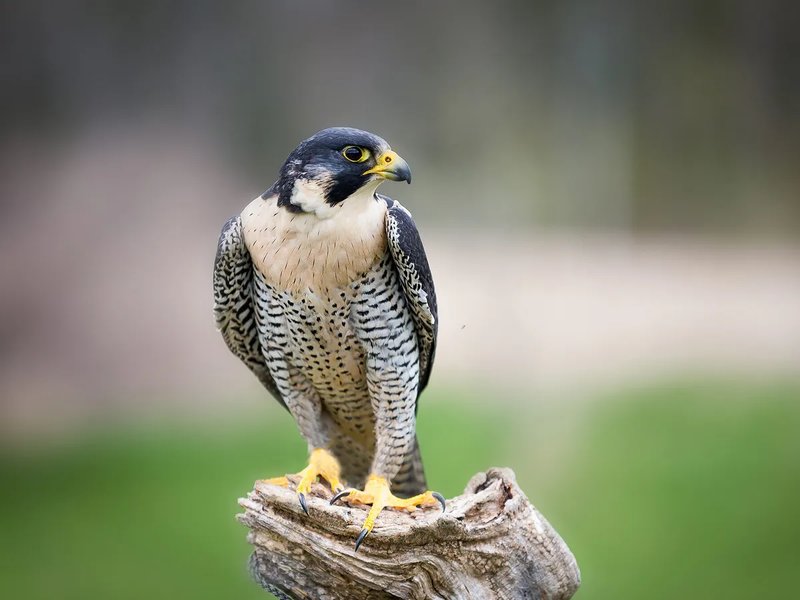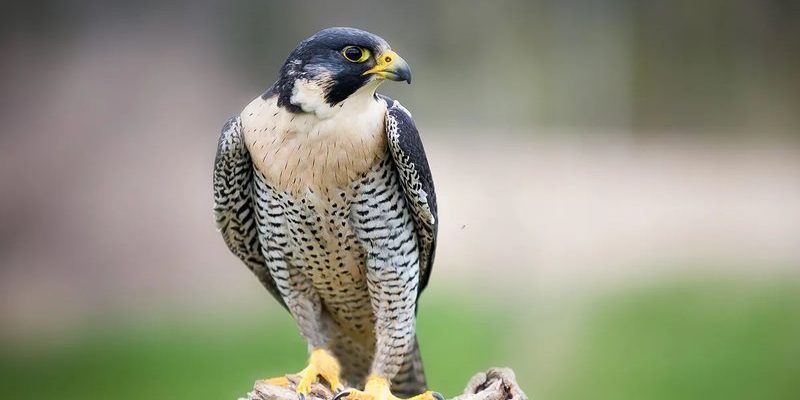
If you’re curious about these feathered relatives and want to differentiate them from the agile Peregrine, you’re in the right place. We’ll dive into 10 animals that share characteristics with the Peregrine Falcon, examining their unique traits and how to spot the differences. So grab a cup of coffee, and let’s explore the world of birds of prey together!
1. Merlin
The Merlin is a small but fierce falcon that’s often found in open habitats like grasslands and coastal regions. It’s a compact bird, measuring about 10 to 12 inches long, which is smaller than the Peregrine. You might be wondering what sets it apart from its faster cousin.
For starters, Merlins have a stockier build, with shorter wings and a broader tail. They feature dark blue-gray plumage, especially in males, contrasting with the Peregrine’s slate-colored feathers. Plus, while the Peregrine is a master at high-speed dives, Merlins prefer to chase down their prey in quick bursts over short distances. If you see one zipping low across a field, that’s likely a Merlin!
2. Prairie Falcon
Next up is the Prairie Falcon, a bird that thrives in the open plains of the western U.S. and Canada. At about 14 to 18 inches long, they’re slightly larger than Merlins but smaller than Peregrines. Their most distinctive feature is the light brown streaked plumage, which helps them blend into their dry surroundings.
Unlike the Peregrine, which has a blue-gray back and a distinctive black “mustache” mark, Prairie Falcons sport a lighter, more uniform look. If you spot one perched on a cliff or soaring high, take note of its longer wings, which are more suited for gliding. This allows them to conserve energy while watching for small mammals or birds to hunt.
3. Gyrfalcon
If you want to see a bird that’s almost a mirror image of the Peregrine, look no further than the Gyrfalcon. This is the largest of the falcon species, measuring up to 24 inches long. Gyrfalcons come in several color variations, including gray, white, and dark brown.
What really makes them stand out is their immense size and powerful build. While Peregrines are built for speed, Gyrfalcons are designed for strength. They have a more robust body and larger beak, making them capable of tackling larger prey. If you’re in the Arctic or subarctic regions, you might spot a Gyrfalcon soaring above the tundra, hunting for birds and small mammals.
4. American Kestrel
The American Kestrel is a pint-sized raptor, measuring only about 9 to 12 inches, but what it lacks in size, it makes up for in vivid colors. Males showcase stunning blue-gray wings and rich rust-colored backs, while females are more muted but equally beautiful.
These little falcons are often seen hovering in mid-air, looking for small rodents and insects. While the Peregrine is known for its astonishing speed, Kestrels have a more playful hunting style, short bursts of speed that can surprise unsuspecting prey. If you see a tiny falcon fluttering in the sky, there’s a good chance it’s an American Kestrel.
5. Eurasian Sparrowhawk
The Eurasian Sparrowhawk is a small bird of prey found across Europe and Asia. Comparable in size to the Merlin, it measures around 12 to 15 inches. What sets it apart is its distinctively rounded wings and long tail, which give it incredible maneuverability in wooded areas.
While Peregrines prefer open spaces, Sparrowhawks thrive in forests, hunting small birds in midair. They have a unique hunting style, often relying on stealth and quick maneuvers to surprise their targets, rather than sheer speed. When you see a flurry of feathers in the woods, take a moment; you might just catch a glimpse of this crafty hunter.
6. Red-tailed Hawk
The Red-tailed Hawk is one of North America’s most well-known birds of prey. Recognizable by its distinctive reddish-brown tail, this hawk is larger than the Peregrine and can grow up to 26 inches in length.
Unlike the sleek Peregrine, Red-tailed Hawks have broad, rounded wings that allow for soaring rather than speed. They often sit on fence posts or trees scanning for prey. If you spot this majestic bird perched high, listen for its signature call—it’s a sound that many of us associate with the wild.
7. Osprey
You might recognize the Osprey by its unique appearance — a large, fish-eating raptor with long, curved wings. Measuring about 20 to 26 inches long, Ospreys are often spotted hovering over water bodies, scanning for fish below.
What differentiates Ospreys from Peregrines is their hunting technique. Ospreys dive into the water to catch their meals, while Peregrines focus on aerial targets. Ospreys have specialized talons designed for gripping slippery fish, making them excellent fishers. If you see one hovering over a lake, prepare for the splash as it plunges below the surface!
8. Cooper’s Hawk
The Cooper’s Hawk is another forest-dweller, similar in size to the Sparrowhawk but a bit larger, measuring around 14 to 20 inches. These agile birds excel at navigating through dense trees to hunt other birds.
Unlike the Peregrine, Cooper’s Hawks rely on their exceptional agility rather than speed. If you’re in a suburban area, look for them in your backyard, darting after small birds at high speeds. Their rounded wings and long tails help them weave through branches with ease, which is a remarkable sight!
9. Accipiter Hawks
Accipiter Hawks, like the Cooper’s Hawk, belong to a group known for their swift hunting abilities. They feature short, rounded wings and long tails that aid in navigating swiftly through the trees. This group includes species such as the Northern Goshawk and Sharp-shinned Hawk.
While they may have some similarities in flight style to the Peregrine, their hunting techniques are more about stealth and surprise than speed. They primarily hunt smaller birds, using their agility to launch quick attacks in forested habitats. If you see a hawk dart through the trees, it could belong to this agile group.
10. Black-shouldered Kite
Lastly, the Black-shouldered Kite is a stunning raptor often found in open fields and farmlands. Recognizable by its striking black shoulder patches and pure white body, this bird is about the same size as the American Kestrel.
These kites have a unique hovering behavior, which resembles that of the Kestrel. While they share some similarities with the Peregrine, such as sharp hunting instincts, they primarily hunt small mammals. If you see a kite hovering stunningly against the backdrop of a blue sky, you’re surely looking at a Black-shouldered Kite.
In conclusion, while the Peregrine Falcon is a standout bird known for its unmatched speed, there’s a diverse world of raptors that share similar traits. From the diminutive Kestrel to the powerful Gyrfalcon, each bird has its own unique charm and hunting strategy. So, whether you’re a birdwatching enthusiast or just starting, knowing how to distinguish these remarkable creatures can make your outdoor adventures even more rewarding. Keep your eyes to the sky; you never know what you’ll spot!

